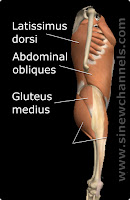Note: This post is adapted from a post that originally appeared on the Sports Medicine Acupuncture Blog site which can be found here.
Jingjin Movement Training presentation at the Pacific Sports & Orthopedic Acupuncture Symposium
One of the features of the Sports Medicine Acupuncture program, where I am a faculty member, is the emphasis on the channel sinews or jingjin. These are highlighted in dissection classes, but also in the assessment and treatment classes and in the corrective exercise classes. The jingjin are an important part of the channel system and I have been exploring movement patterns of these channels since 1998; I am currently developing qigong and calisthenics patterns to strengthen the channel, improve body awareness and control, and improve the channel health. This is something that I will be presenting on at the upcoming Pacific Sports and Orthopedic Acupuncture Symposium from March 30th to April 3rd.
While you can look at the movement patterns of a particular channel, it is actually better to look at more comprehensive functional movement patterns that involve multiple related channels. For instance, there are movements that lift you into an upright and expansive posture. These movements involve an engagement of the back muscles which pull down on the pelvis and spine and lift the front channels, as seen in this excellent illustration to the left from an anatomy atlas by John Hull Grundy. The full, expansive and upright posture that is the result of the back engagement occurs with a stabilization from a balanced, aligned and strong core where the respiratory diaphragm is aligned with the pelvic floor as seen in the illustration below.
This overall pattern involves the Taiyang-Shaoyin channels. The video below from my Youtube channel and featuring something I refer to as a Hanging Squat highlights these channels well. This exercise is a simpler version of an exercise called a front lever. The position on the upright portion of the movement calls on muscles of the UB and SI jingjin such as the gluteus maximus, the erector spinae, the lats, and the shoulder external rotators, but also the transverse abdominis and multifidi from the KID jingjin are engaged and the pelvic and respiratory diaphragms are aligned. The exercise can be modified and made easier or harder by decreasing or increasing the angle the body makes with the ground when in the up position. This would be a great exercise for many shoulder and back conditions especially if these muscles are underutilized. Of course, care should be taken and it is not appropriate for everyone. Understanding the mechanisms helps find modification or related exercises which work the same channels.
The Shaoyang-Jueyin channel network is involved with side bending, stabilization of the sides and rotation. If you look at the muscles that cause movement (or prevent too much of it) along the sides, and also the ones that rotate the major segments of the body, these are generally the same muscles. The abdominal obliques are a great example of this.
The interplay between these movements is seen in the video below, which is a standing version of an exercise called the Human Flag. Notice the innominate bone movement in particular that makes this movement shine. This could be used as a great sacroiliac joint exercise for patients and It can be scaled back and made achievable for most patients.
The final movement pattern is controlled by the Yangming-Taiyin channel network. This involves flexion of the major joints and pulls you down. It also helps move the shoulder blades. I don’t have a good video that highlights these channels and will have to expand on them at the symposium. Here is an extraordinary gymnastic maneuver, however, that exemplified this channel network. This is beyond most patients, unless they are a gymnast. It is beyond what I can do, though there are many ways to modified this and/or train elements of this to simulate these channels. Another characteristic movement would be a handstand using proper abdominal support (no banana back) or even a V sit as demonstrate below by Gabo Saturno from Saturnomovement.com
I hope you can make it! If you are there, I will also be leading the morning qigong sessions from 7-7:30am out by Mission Bay. Many of these themes will be presented, but I will not be explaining everything in these morning sessions. So, there will be simple instruction and this will be expanded on during the Thursday, March 30th lectures. So, the morning sessions are a time to play. Practice and explore our own movement potentials.











No comments:
Post a Comment